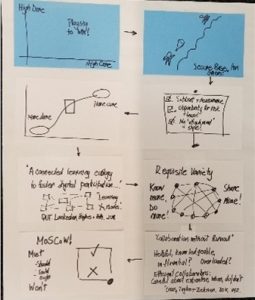9 Strategy Journey Maps
Strategy Journey Maps

Organisations of all kinds, including government agencies, struggle with their strategy development processes and creating a strategic vision. The process can be onerous, mind-numbing, and overly complex. Many of the tools and processes that are available are opaque and it can be challenging to connect the dots!
We also know that when we can include key stakeholders and those who will be delivering on the strategy, the strategy is more likely to be adopted and indeed likely to be successful. What is shared and co-created is more likely to be actioned!
And once the strategy is developed, sharing the journey and showing the outcomes can be difficult to process and understand.
The Strategy Journey Map process is an interactive and real-time way that leaders, key internal stakeholders, and indeed the recipients of the strategy, can be productively and powerfully involved.
Strategy Journey Mapping is a visual, icon-driven, flexible process that enables strategy facilitators and participants to identify, share and link the various components of strategy making. The process begins with a checklist of possibilities, sectioned into the overall components that are potentially possible as inputs to an advanced agency or departmental strategy.
Here is a short overview of the use of the strategy journey map in a public sector context.
https://blogs.qut.edu.au/qutex/2020/02/25/strategy-journey-mapping-pathways-to-success/
Senior leaders, department heads, ministers, and boards as well, set the overall vision, objectives and ensure that the strategy aligns with the entity’s values and overall purpose. The Strategy Team sets the visual framing for the Strategy Journey Map. For some organisations, the framing might be a checker-board approach. For others, it might be a pyramid, or a mind map.
Regardless, the framing is itself a representation of the entity. Be sure to check what story it is telling! Too constricted and inflexible, and we might be limiting possibilities!
Overall the Strategy Journey Map Frame should be easy to share, it should enable icons within it to move and change, there should be a visual way to link icons, and they should be easy to move and link.
A crucial element of a strategy journey is an understanding of the knowledge, skills and capabilities of the process. One way to achieve this is as a team, to share in a visual format, the many and varied elements of these within the team.
The process of Strategy Journey Mapping
 We start with an overview of our current strategy, perhaps in Checklist or Icon form, or a draft of our objectives and the proposed value outcomes of the project.
We start with an overview of our current strategy, perhaps in Checklist or Icon form, or a draft of our objectives and the proposed value outcomes of the project.
This is an overview of the fundamentals of strategy making. For example, external analysis and trend impact, are essential components of any strategy-making process. We will always have something in our organisations that ‘looks like’ our current strategy.
Next for each component of the strategy-making process, we choose tools and processes that help us achieve the analysis and insights that are necessary for good strategy-making.
The result is a myriad and mosaic of tools and processes that are available and suitable for the process. The system that has been created at the Graduate School of Business at QUT, holds a suite of tools and processes, icon-style, that are fit for purpose and ready to apply.
Activity
Think of a recent project that worked well for you. You might be happy to choose the one associated with your Success Story. What are the key tools, processes, models, ways of thinking, software programs you have used, to create that success?
Now, using a technique such as rich pictures, mapping, mind-mapping, or some other visual approach, create a ‘strategy map’ of the process. Make sure you do this in a way that ‘tells a story’ and that you can share. Ideally, your peer who will be reviewing this, should be able to follow the ‘story’ without you telling it!
Remember that we are working virtually so be prepared to share, in the manner that you wish, with at least one other peer.

The total visual framework is then ready for a sense check, and the vital step of creating links and connections with the system. We also can check to see that key elements are covered, that vital elements, connections and stakeholders are involved.
Now the real power begins. Because of the layout and visuality of the framework, we can ‘see’ the whole. The links and nodes are clear. Potential inputs from one tool to another are shown. Missing stakeholder input is easy to identify.

And the process begins. The various stakeholders and strategy team members can workshop the tools and models. The input is modular, it is real, and the process is creative and invigorating. Ideally, the mapping takes place as a three-dimensional strategy room, with the tools and models mapped and posted as separate yet integrated activities and activity groups.

Because the journey is integrated rather than linear, outputs and insights are more real-time, systemic and holistic.
And it becomes a powerful driver of ACTION!
Because all stakeholders and key components of strategy making are involved immediately, the key leaders can get on with the job of enacting and enabling!

It isn’t a ‘strategy from the top’ model. It becomes a strategy from within! And who truly knows better than those who do! The overall process reflects the whole rather than being imposed and potentially removed and isolated from the delivery mechanisms and the machinery of government.
Think of this as a puzzle. Where all the stakeholders create the pieces, and the strategy team assembles. Sure – some pieces won’t fit, and there will be missing pieces and gaps. But we can SEE! Then get on with creating the whole.
